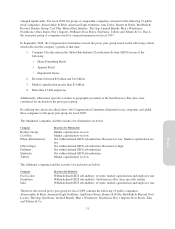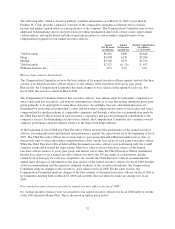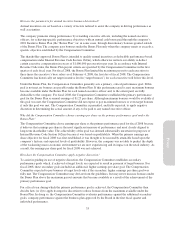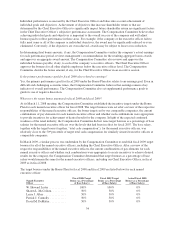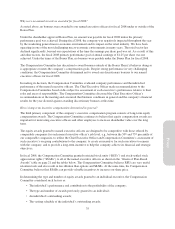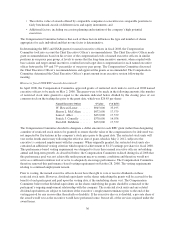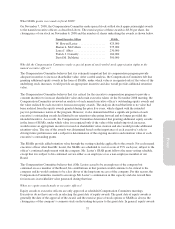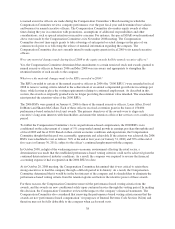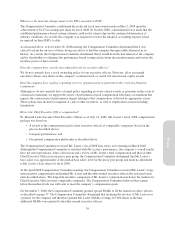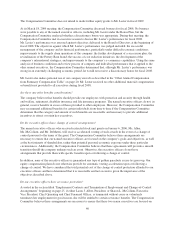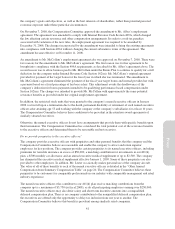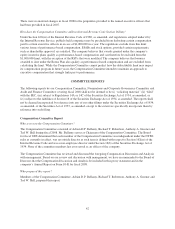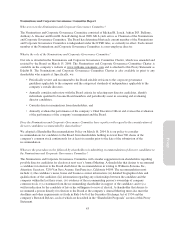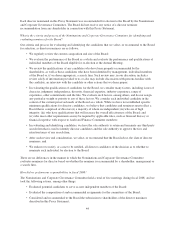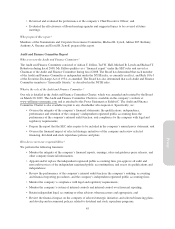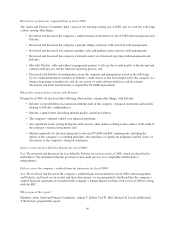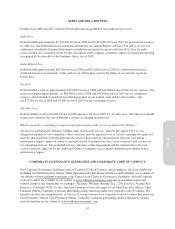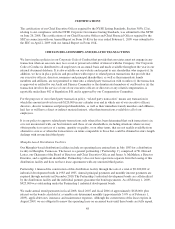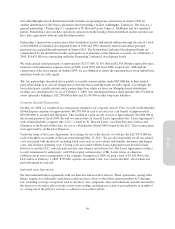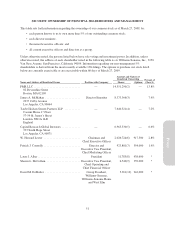Pottery Barn 2008 Annual Report Download - page 139
Download and view the complete annual report
Please find page 139 of the 2008 Pottery Barn annual report below. You can navigate through the pages in the report by either clicking on the pages listed below, or by using the keyword search tool below to find specific information within the annual report.
the company’s goals and objectives, as well as the best interests of shareholders, rather than potential personal
economic exposure under these particular circumstances.
On November 7, 2008, the Compensation Committee approved the amendment to Ms. Alber’s employment
agreement. The agreement was amended to comply with Internal Revenue Code Section 409A, which changed
the law affecting certain severance and other compensation arrangements. In order to avoid tax penalties
associated with violations of the new rules, the employment agreement was required to be amended by
December 31, 2008. The changes incorporated by the amendment were intended to bring the existing agreements
into compliance with Section 409A without changing the current substantive terms of the agreement. The
amendment became effective on November 11, 2008.
An amendment to Ms. McCollam’s employment agreement also was approved on November 7, 2008. There were
two reasons for the amendment to Ms. McCollam’s agreement. The first reason was for her agreement to be
brought into compliance with the Section 409A requirements as described for Ms. Alber’s agreement above. The
second reason was to allow bonuses paid to Ms. McCollam under the Bonus Plan to continue to qualify for a full
deduction for the company under Internal Revenue Code Section 162(m). Ms. McCollam’s original agreement
provided for payment of her target bonus for the fiscal year in which she was terminated. The amendment to
Ms. McCollam’s agreement eliminated the payment of her fiscal year target bonus and instead provides her with
a payment based on a fixed percentage of her base salary. This adjustment avoids the disallowance of the
company’s deduction for bonus payments intended to be qualifying performance-based compensation under
Section 162(m). The change was intended to provide Ms. McCollam with approximately the same potential
severance benefits as provided under her original employment agreement.
In addition, the restricted stock units that were granted to the company’s named executive officers in January
2006 vest in full upon a termination due to the death, permanent disability or retirement of such named executive
officers after attaining age 55 and working with the company or the company’s subsidiaries for at least 10 years.
The Compensation Committee believes these conditions to be prevalent in the retention award agreements of
similarly situated executives.
Otherwise, the named executive officers do not have arrangements that provide them with specific benefits upon
their termination. The Compensation Committee has considered the total potential cost of the severance benefits
to the executive officers and determined them to be reasonable and not excessive.
Do we provide perquisites to the executive officers?
The company provides executive officers with perquisites and other personal benefits that the company and the
Compensation Committee believe are reasonable and enable the company to attract and retain superior
employees for key positions.The company provides certain perquisites to its named executive officers, including
premiums for term life insurance in excess of $50,000, a matching contribution for investments in our 401(k)
plan, a $500 monthly car allowance and an annual executive medical supplement of up to $2,500. The company
has eliminated the executive medical supplement effective January 1, 2009. Some of these perquisites are also
provided to other employees. In addition, Mr. Lester occasionally makes personal use of the company aircraft.
The value of all of these benefits to each of the named executive officers is detailed in the “Other Annual
Compensation from Summary Compensation Table” on page 20. The Compensation Committee believes these
perquisites to be customary for comparable professionals in our industry with comparable management and retail
industry experience.
The named executive officers who contribute to our 401(k) plan receive matching contributions from the
company up to a maximum of $5,750 (in fiscal 2008), as do all participating employees earning over $230,000.
The named executive officers may also defer salary and short term incentive amounts into a nonqualified
deferred compensation plan. There is no company contribution to the nonqualified deferred compensation plan;
the executives are offered only the opportunity to delay tax inclusion from one year to another. The
Compensation Committee believes this benefit is prevalent among similarly sized companies.
41
Proxy


